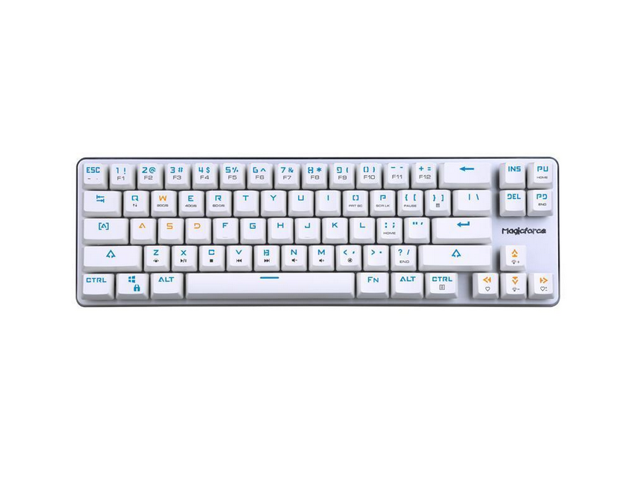


MAGICFORCE 68 BLUETOOTH
There was a side idea, that apart from the regular bluetooth keyboard functionality to add U2F and/or GPG SmartCard support. The NRF52840 offers all these goodies (while the BLE SC support for arduino is under development at the time of writing) but I had to spend money before even having a PoC. I love the NRF52 family, but after a bit of research I learned that the 52832 does not have USB support and does not have a “CryptoCell”, which means a crypto accelerator which mean no BLE Secure Connecttion. I had an Adafruit Feather Bluefruit at hand, based on the marvellous NRF52832. The idea begun with my frustration with wires - right, bluetooth. Ok, so now we know what we’re up against. It’s empty, but it’s VERY time consuming to remove all the buttons so here are some photos: Also, (spoiler) I ended up desoldering all of the switches to create my own keyboard so I got access to the front of the PCB. Matrix to MCU pin mapping (Rows: Top to Bottom, Columns: Left to Rigth): NameĪll LEDs have a common cathode on Pin 39 - PA5/SDIA/TP1_0 and a common anode to Vcc. It is a classic matrix-diode style keyboard, it gives logical 1 (5V if I remember correct) to rows and reads it from the columns (that way because of the direction of the diodes). Seems fucked up (no docs, too expensive, not gonna work on linux/open source software, etc.). But they refer to a “Holtek Writer” as the programmer AND debugger. UDN/GPIO0 - USB D-, used for programmingĭebugging & programming are different procedures, according to the datasheet, they use different pins.Reset/OCDSCK - Used for debugging & programming.It exposes in the 5 pin header (bottom left on photo):

It uses the Holtek HT68FB550 MCU - Datasheet - LQFP48 package Post- Graduate studies in Chemistry were introduced in 1993-94.Pretty simple schematic, hackable to the bone Higher secondary streams in Arts, Science and Commerce were introduced in 1983. Teaching facilities at the Post-Graduate level were first initiated in the Department of History in 1979 and such facilities were extended to the Departments of Economics, Commerce and Political Science in 19 respectively. Honours teaching provisions were made during the years 1968-73. The college was upgraded to a FIRST GRADE COLLEGE in 1961 with the opening of Under Graduate classes in Science and Humanities streams in 19 respectively. The statue of this great erudite scholar adorns the central place of the main building of the college. of Orissa very aptly decided in 1951 to rechristen the erstwhile "JEYPORE COLLEGE" as "VIKRAM DEV COLLEGE". As a tribute to his monumental contributions the Govt. Maharaja Vikram Dev Verma was a great patron of art, learning and culture in this neglected part of Orissa. The college began with only 49 students, 09 teachers and 20 boarders in the hostel. Dwivedy joined the college as its first Principal on 06-07-1947. The college started functioning from 01-07-1947 as "JEYPORE COLLEGE" and Sj. His Diwan and other prominent citizens of the area extended all possible help and co-operation for this noble cause. The philanthropist King Rajarshi Vikram Dev Verma who once ruled the state of Jeypore donated land and buildings for the college. of Orissa evinced keen interest in starting a college at Jeypore from the session 1947-48. Out of the intense desire of the public of this locality for the spread of higher education in this backward tribal area and in response to heavy public demand, the Govt. Catering to more than 5000 students, Vikram Deb (Autonomous) College is considered among the best and most sought after colleges in south Odisha. This College has produced many distinguished personalities and leaders in diverse fields of life. It is an honour and a privilege to be the Principal of Vikram Deb (Autonomous) College, the College that stands for excellence and continuously sets high standards in Academics. "I welcome you to Vikram Deb (Autonomous) College with pride. The name of the college is inscribed in English at the bottom. The waterfall next to the wheel stands for the scenic spots and natural potentialities of the locality. The Konark wheel not only indicates the achievement of the people of Orissa in the field of art and architecture but also stands for progress. The book and lamp are the eternal symbols of knowledge and light. The motto written in Sanskrit Devanagari script on the top is a prayer for leading humanity from darkness to light.


 0 kommentar(er)
0 kommentar(er)
